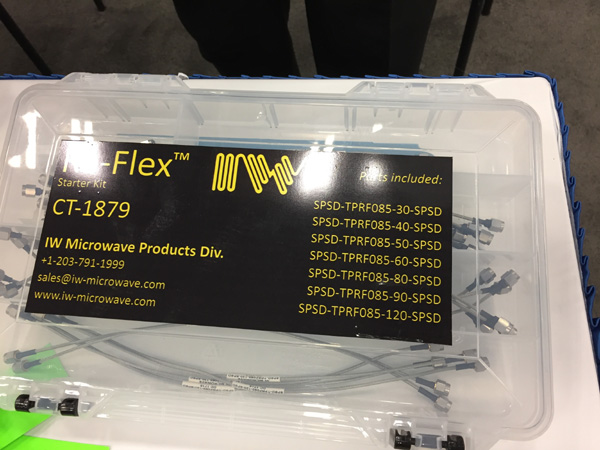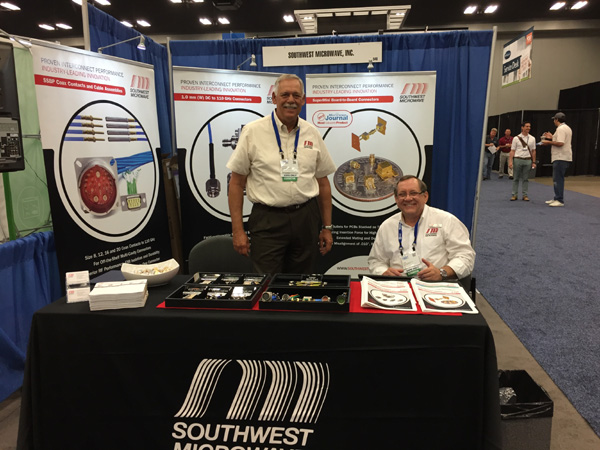This is the first year that NIWeek has taken place in late May instead of its normal early August time slot and switches permanently to this part of the calendar. NIWeek 2017 kicked off with new CEO Alex Davern paying tribute to Dr. T with a standing ovation from the audience.  Eric Starkloff, EVP of Global Sales and Marketing, outlined how the industry is moving very quickly with 5G, autonomous cars and commercialization of space. As 5G schedules get pulled in, researchers and companies need to proto-type quickly and NI has been equipping many of them with their platform. An example is the 28 GHz channel sounder, aka the porcupine, which is allowing AT&T to measure all directions in real time which previously was not practical. Also in this area, they announced new 28 GHz radio heads for the mmWave transceiver system. They transmit and/or receive up to 2 GHz of bandwidth in real time.
Eric Starkloff, EVP of Global Sales and Marketing, outlined how the industry is moving very quickly with 5G, autonomous cars and commercialization of space. As 5G schedules get pulled in, researchers and companies need to proto-type quickly and NI has been equipping many of them with their platform. An example is the 28 GHz channel sounder, aka the porcupine, which is allowing AT&T to measure all directions in real time which previously was not practical. Also in this area, they announced new 28 GHz radio heads for the mmWave transceiver system. They transmit and/or receive up to 2 GHz of bandwidth in real time.
DARPA took the stage to discuss their spectral co-existence program, The Spectrum Collaboration Challenge (SC2). The SC2 challenges teams to develop wireless devices will have full access to the increasingly crowded electromagnetic spectrum by finding new spectrum access strategies and develop a new wireless paradigm in which radio networks will autonomously collaborate and reason about how to share the RF spectrum, avoid interference, and jointly exploit opportunities to achieve the most efficient use of the available spectrum. DARPA has selected 30 teams for Phase 1 of a $3.75 million competition to kick it off later this year. Teams will battle in the “Coliseum,” a next-generation electronic emulator of the invisible electromagnetic world with impressive attributes: 65,536 channel interactions, 25.6 GHz of instantaneous bandwidth, 52.43 TB/s of digital RF data and 1.88 TB of scenario model data. Could this be the beginning of 6G goals?
 Luke Schreier, Director of Product Management and Marketing, announced NI DAXmx support for Python, Nanovoltmeter (32 channels, 18-28 bit, 2 MS/s) plus PXI AWG, oscilloscope, remote controller and rubidium clock source & pulse pattern generator. There was also a major addition with the NI ATE core configurations announced. NI now offers custom ATE configurations that include core mechanical, power and safety infrastructure for ATE with partners to complete the needed features not supplied by NI.
Luke Schreier, Director of Product Management and Marketing, announced NI DAXmx support for Python, Nanovoltmeter (32 channels, 18-28 bit, 2 MS/s) plus PXI AWG, oscilloscope, remote controller and rubidium clock source & pulse pattern generator. There was also a major addition with the NI ATE core configurations announced. NI now offers custom ATE configurations that include core mechanical, power and safety infrastructure for ATE with partners to complete the needed features not supplied by NI.
NI announced the integration of Time Sensitive Networking (TSN) Into the CompactDAQ Platform with new 4- and 8-slot Ethernet chassis that deliver time-based synchronization over Ethernet to the CompactDAQ platform for distributed measurement and test systems. These achieve sub-microsecond synchronized timing over standard Ethernet.
 While LabView 2017 was released with new features, it was the next generation of the platform, LabVIEW NXG 1.0, which was the star of the event. Built on modern day code, the new platform is available with LabVIEW 2017 at the same price and offers the next generation of LabVIEW engineering system design software. LabVIEW NXG bridges the gap between configuration-based software and custom programming languages with a new approach to measurement automation. “Thirty years ago, we released the original version of LabVIEW, designed to help engineers automate their measurement systems without having to learn the esoterica of traditional programming languages. LabVIEW was the ‘nonprogramming’ way to automate a measurement system,” said Jeff Kodosky, NI cofounder and business and technology fellow, known as the ‘Father of LabVIEW.’ “For a long time we focused on making additional things possible with LabVIEW, rather than furthering the goal of helping engineers automate measurements quickly and easily. Now we are squarely addressing this with the introduction of LabVIEW NXG, which we designed from the ground up to embrace a streamlined workflow. Common applications can use a simple configuration-based approach, while more complex applications can use the full open-ended graphical programming capability of the LabVIEW language, G.”
While LabView 2017 was released with new features, it was the next generation of the platform, LabVIEW NXG 1.0, which was the star of the event. Built on modern day code, the new platform is available with LabVIEW 2017 at the same price and offers the next generation of LabVIEW engineering system design software. LabVIEW NXG bridges the gap between configuration-based software and custom programming languages with a new approach to measurement automation. “Thirty years ago, we released the original version of LabVIEW, designed to help engineers automate their measurement systems without having to learn the esoterica of traditional programming languages. LabVIEW was the ‘nonprogramming’ way to automate a measurement system,” said Jeff Kodosky, NI cofounder and business and technology fellow, known as the ‘Father of LabVIEW.’ “For a long time we focused on making additional things possible with LabVIEW, rather than furthering the goal of helping engineers automate measurements quickly and easily. Now we are squarely addressing this with the introduction of LabVIEW NXG, which we designed from the ground up to embrace a streamlined workflow. Common applications can use a simple configuration-based approach, while more complex applications can use the full open-ended graphical programming capability of the LabVIEW language, G.”
In the exhibition, I visited many of the high frequency companies displaying their products and services:
Ettus Research is a NI company and leading supplier of software defined radio platforms, including the Universal Software Radio Peripheral (USRP™) family of products. With a low overall system price, expansive capabilities, and software availability, USRP products are used by thousands of engineers worldwide and remain a top choice in software defined radio hardware for algorithm development, exploration, and prototyping. The USRP family of products is designed for RF applications from DC to 6 GHz, including MIMO systems. Example application areas include white spaces, mobile phones, public safety, spectrum monitoring, radio networking, cognitive radio, satellite navigation, and amateur radio.
 H+S was featuring their second member of the SUCOFLEX 500 product family, the SUCOFLEX 526S. It has excellent phase and amplitude stability under bending plus good return loss and insertion loss. It operates up to 26.5 GHz with robust and precise positioning of 3.5 mm centre conductor. The cables are torque, crush and kink resistance plus have abrasion, moisture and dust resistance. The SUCOFLEX 526S is suitable for applications such as test rack systems, and bench-top, field or RF production tests with high throughput rates.
H+S was featuring their second member of the SUCOFLEX 500 product family, the SUCOFLEX 526S. It has excellent phase and amplitude stability under bending plus good return loss and insertion loss. It operates up to 26.5 GHz with robust and precise positioning of 3.5 mm centre conductor. The cables are torque, crush and kink resistance plus have abrasion, moisture and dust resistance. The SUCOFLEX 526S is suitable for applications such as test rack systems, and bench-top, field or RF production tests with high throughput rates.
 Insulated Wire (IW) is now offering Re-Flex Starter Kits, re-formable cable assembly solutions right out of the box. Each kit comprises seven different assembly lengths (3, 4, 5, 6, 8, 9 and 12”) with 6 pieces each. The kit provides the design engineer with a convenient aid for performing cable routing in prototype system builds.
Insulated Wire (IW) is now offering Re-Flex Starter Kits, re-formable cable assembly solutions right out of the box. Each kit comprises seven different assembly lengths (3, 4, 5, 6, 8, 9 and 12”) with 6 pieces each. The kit provides the design engineer with a convenient aid for performing cable routing in prototype system builds.
MegaPhase’s new Mega110 flexible and semi-rigid cable is a 110 GHz cable specifically designed for high-bandwidth applications. These cable assemblies allow for stable transmissions at a high-frequency bandwidth ranging from DC to 110 GHz. The lightweight cable have precision 1.0mm connectors are used for repeatable measurements with mode free operation to 110 GHz. Mega Phase has also added passive products to their portfolio including standard and custom products like dividers and couplers.
Polyphase Microwave was displaying their new C- and X-Band PXIe block up/down converters. They feature two integrated independent LO synthesizers, automatic LO feed-through calibration, 1 GHz I/Q bandwidth and 30 dB/1dB step, programmable RF attenuation. It supports applications such as quantum computing, 5G testing, Doppler weather radar and vector signal transceiver.
RADX LibertyGT® 1211B is a modular, COTS, multifunction, programmable, bench-top Automated Test System (ATS) that supports a wide range of real time RF and Microwave Stimulus, Test and Measurement (T&M) applications. It features a modular Software Defined Synthetic Instrument (SDSI®) architecture, intuitive touch screen interface and industry leading programmability. RADX has added 8 TB RAID capabilities to enable the streaming of full bandwidth to RAID drive with 765 MHz of bandwidth. The real time VSG now has up to 128 channels.
Rosenberger North America developed the series WSMP® connector based on the SMP series. They are designed in very small dimensions and very high frequencies up to 100 GHz. WSMP connectors are about 45 % smaller than SMP connectors, and feature a high packing density, have a push-on coupling mechanism and need a minimum board-to-board distance of 3.05 mm. Optimized for high frequency applications, they provide customer-specific footprints and layout recommendations.
 Southwest Microwave addressed the performance issues of legacy SMP technology with a “ground up” design approach in developing a unique suite of SuperMini Board-to-Board DC to 67 GHz connectors. These ultra-high frequency, miniaturized push-on interconnect solutions for high density PCB interface feature advanced bullet and receptacle construction that maximize product life-span and significantly improve resilience against RF signal degradation. Ideal for defense, aerospace, communications, networking and test applications, these lightweight yet rugged blind-mate connectors enhance reliability and performance for board-to-board stacking, edge-mount to backplane or board-to-panel interconnections.
Southwest Microwave addressed the performance issues of legacy SMP technology with a “ground up” design approach in developing a unique suite of SuperMini Board-to-Board DC to 67 GHz connectors. These ultra-high frequency, miniaturized push-on interconnect solutions for high density PCB interface feature advanced bullet and receptacle construction that maximize product life-span and significantly improve resilience against RF signal degradation. Ideal for defense, aerospace, communications, networking and test applications, these lightweight yet rugged blind-mate connectors enhance reliability and performance for board-to-board stacking, edge-mount to backplane or board-to-panel interconnections.
Teledyne Microwave Solutions has developed a line of synthesizers that capitalizes on years of experience building some of the industry’s lowest phase-noise YIG oscillators. These synthesizers are modular and can be configured in a variety of shapes, sizes, frequency coverage and interfaces. Using the latest phase locked loop techniques, the cost is kept low to allow implementation in a variety of test instrument applications. They were featuring a 2 to 13 GHz operating frequency range with 1 MHz step size, 10 dBm min/ 16 dBm max output power. Spurious signals are -60 dBc max and harmonics -20 dBc max.

